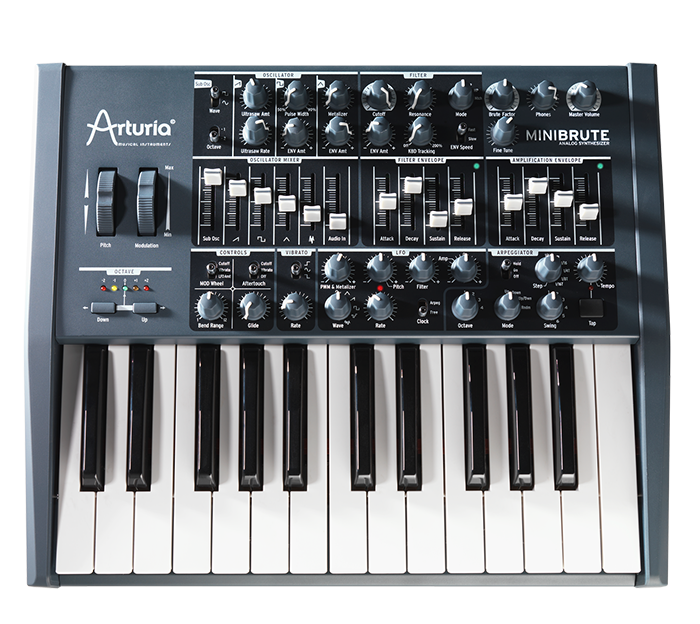
During a few of my jam sessions I’d got a little frustrated at the Minibrute, and was getting fairly convinced that it didn’t make any decent sounds. So I went back over the youtube videos which I’d used as pre-purchase research and put my mind at rest. This thing definitely kicks arse and I’ve just been doing it wrong.
Part of the problem stems from the lack of a sequencer. I can’t play keys by any stretch of the imagination nor do I have enough time or hands with all the knob twiddling I need to get on with. So I’d been using the arpeggiator which, although useful in its niche, is not the full solution – after all it’s an arpeggiator rather than a sequencer.
Gating Switch
On the back of the Minibrute there is a 3-way slider for selecting a gating mechanism. There are 3 options – Keyboard (note plays when key is pressed), hold (note plays continuously), and audio (note plays when incoming audio reaches some threshold). Although not on the front panel, the switch is easy enough to activate blind by reaching over the top of the unit. This means it’s usable to switch the gating mechanism while playing live (the switch itself doesn’t inject any noise into the signal path).

Audio In
The Minibrute has an audio in jack and an associated channel on the VCO mixer. It’s possible to use the incoming audio to trigger the gate while also having the audio turned right down, preventing the Minibrute from processing it. So we can use some audio input for triggering notes even if we don’t want to process the audio.
However, if we increase the audio level in the VCO mixer, it is injected right at the beginning of the signal path … so it will pass through the filters and distortion. I haven’t really experimented with this yet other than distorting a few drum tracks and filter sweeping them. There is certainly some mileage to be had with this.

Selecting An Audio Channel
As I haven’t implemented any insert effects yet, I’ve run the ‘send’ channel from the mixer to the audio in on the Minibrute. This means I can use the individual send level from one or more channels to trigger the gate (and/or process the audio). I’ve found that hats work pretty well – although this may be helped by my tendency toward busy hat lines.
Gate In From Drumbrute
As the Drumbrute has individual outputs for most of the instruments, it is possible to run an output from a drum instrument to the ‘gate in’ on the back of the minibrute. As the ‘zap’ instrument is something I’m certain I’ll never use, it’s an ideal candidate. This gives me a track on the Drumbrute which I can connect to the gate in on the Minibrute. As it’s a drum sequencer, there is no note information but I do get access to swing, accent, randomisation, looper and roller. The randomisation function really adds life to the synth lines when sequencing them as a rhythm operation. This gate in functionality is used with the ‘keyboard’ setting on the gate switch – so I can switch between the drum sequence and the audio in.

It’s worth a quick mention of the metronome here, and its usefulness as a clock signal. Although the Drumbrute has a clock out jack, the metronome is also usable for driving the sync of the Korgs. Where it’s pretty cool is the ability to increase the resolution – it can go from 1/4 to 1/16 notes, so for cool effect we can get the instrument sequence running super fast for certain sections.
Pitch From SQ-1
With gating sorted, there remains the need for pitch information. Although I can play a key and the synth will trigger it according to the gate signal, that still puts me in a position of needing to play a little, and needing that spare hand.
I’ve harnessed the SQ-1 as a 16 note sequencer. This will output gate and Control Voltage to two separate channels. I use channel A to send gate and CV to the Volca Modular, and channel B sends CV (only) to the pitch for the Minibrute. This allows me to use the same pitch for the Modular and the Minibrute, while handling gate independently.
Given that the Minibrute has CV inputs for VCF and VCA as well as pitch, there’s a fair bit of exploration left here too.

Gating As A Performance Parameter
With the above method I have a 3 way switch for gating (note on/off) – selected audio channels from the mixer, hold (on), or from a drum sequencer track. And with the ability to switch them during a peformance the Minibrute will be certain to feature a little more in forthcoming tracks. I’m looking forward to working with the Modular and Minibrute running from the same CV pitch, with the Minibrute’s LFO and arpeggiator and Modular’s variable signal pathing adding the variation.